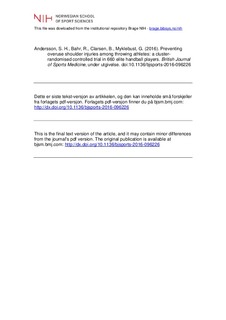| dc.contributor.author | Andersson, Stig Haugsbø | |
| dc.contributor.author | Bahr, Roald | |
| dc.contributor.author | Clarsen, Benjamin Matthew | |
| dc.contributor.author | Myklebust, Grethe | |
| dc.date.accessioned | 2016-10-31T13:42:46Z | |
| dc.date.available | 2016-10-31T13:42:46Z | |
| dc.date.issued | 2016-06-16 | |
| dc.identifier.citation | British Journal of Sports Medicine, 2016, 1-22 . doi:10.1136/bjsports-2016-096226 | nb_NO |
| dc.identifier.uri | http://hdl.handle.net/11250/2418389 | |
| dc.description | Dette er siste tekst-versjon av artikkelen, og den kan inneholde små forskjeller fra forlagets pdf-versjon. Forlagets pdf-versjon finner du på bjsm.bmj.com / This is the final text version of the article, and it may contain minor differences from the journal's pdf version. The original publication is available at bjsm.bmj.com | nb_NO |
| dc.description.abstract | Objective: To evaluate the effect of a comprehensive exercise program designed to reduce the prevalence of shoulder problems in elite handball.
Design: Stratified cluster-randomised controlled trial with teams as the unit of randomisation.
Setting: 45 handball teams (22 female, 23 male) from the two upper divisions in Norway (22 in the intervention group, 23 in the control group) were followed for one competitive season (7 months).
Participants: 660 players aged 16-47 (331 in the intervention group, 329 in the control group).
Intervention: Ten-minute comprehensive exercise program to increase glenohumeral internal rotation, external rotation strength and scapular control, as well as improve kinetic chain and thoracic mobility, to be delivered by coaches and team captains three times per week as a part of the handball warm-up throughout the season.
Main outcome measures: Prevalence of shoulder problems and substantial shoulder problems.
Results: The average prevalence of shoulder problems during the season was 17% (95% CI: 16% to 19%) in the intervention group and 23% (95% CI: 21% to 26%) in the control group (mean difference: 6%). The average prevalence of substantial shoulder problems was 5% (95% CI: 4% to 6%) in the intervention group and 8% (95% CI: 7% to 9%) in the control group (mean difference: 3%). Using generalized estimating equation models, a 28% lower risk of shoulder problems (OR 0.72, 95% CI: 0.52 to 0.98, p=0.038) and 22% lower risk of substantial shoulder problems (OR 0.78, 95% CI: 0.53 to 1.16, p=0.23) was observed in the intervention group compared to the control group.
Conclusion: A comprehensive exercise program reduced the prevalence of shoulder problems in elite handball. | nb_NO |
| dc.language.iso | eng | nb_NO |
| dc.publisher | BMJ | nb_NO |
| dc.subject | sports injury prevention | nb_NO |
| dc.subject | throwing athletes | nb_NO |
| dc.subject | overuse shoulder injuries | nb_NO |
| dc.title | Preventing overuse shoulder injuries among throwing athletes: a cluster-randomised controlled trial in 660 elite handball players | nb_NO |
| dc.type | Journal article | nb_NO |
| dc.type | Peer reviewed | nb_NO |
| dc.subject.nsi | VDP::Social science: 200::Social science in sports: 330::Other subjects within physical education: 339 | nb_NO |
| dc.source.journal | British Journal of Sports Medicine | nb_NO |
| dc.identifier.doi | doi:10.1136/bjsports-2016-096226 | |
| dc.description.localcode | Seksjon for idrettsmedisinske fag / Department of Sports Medicine | nb_NO |
